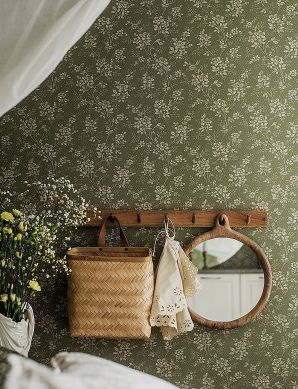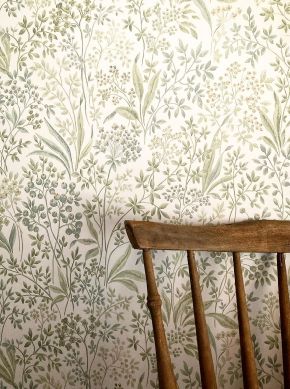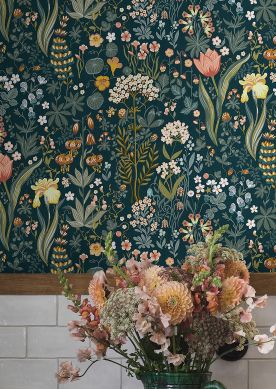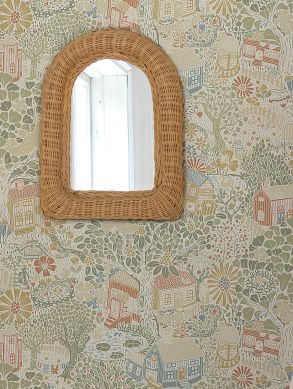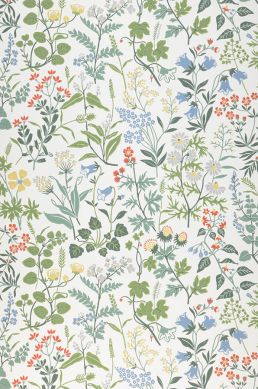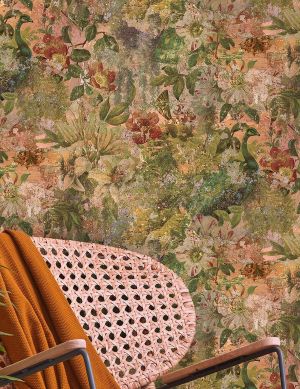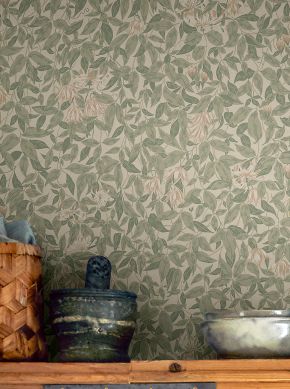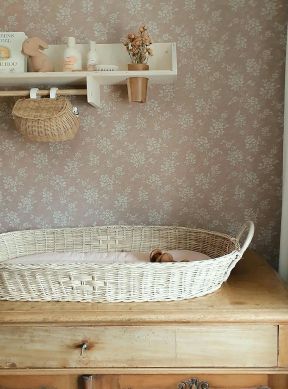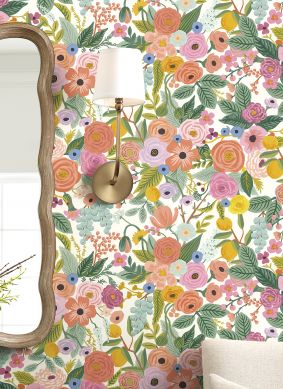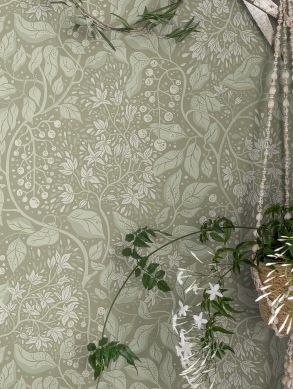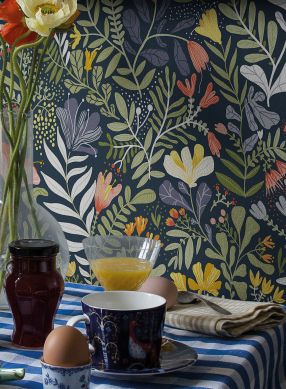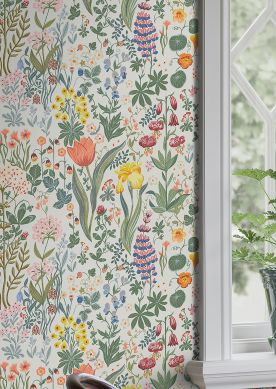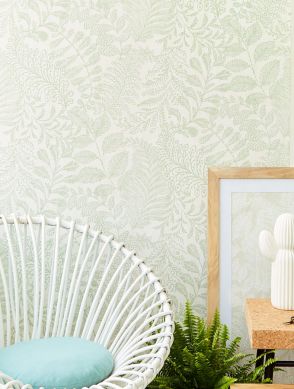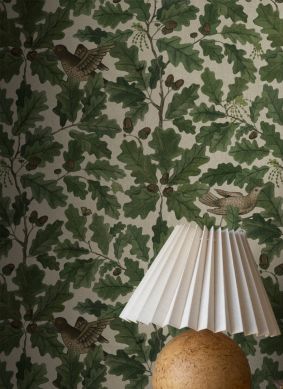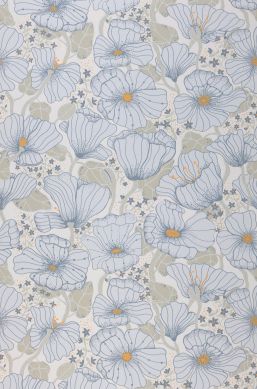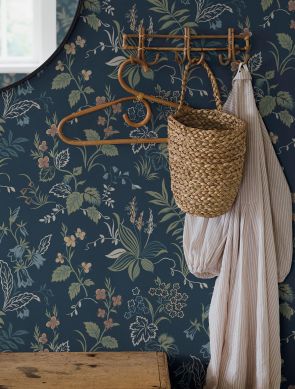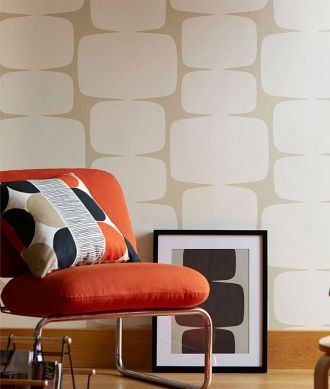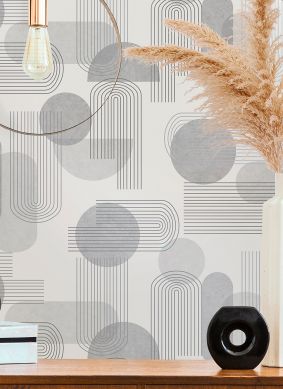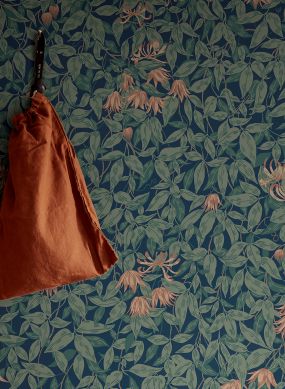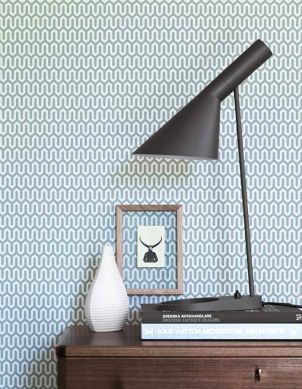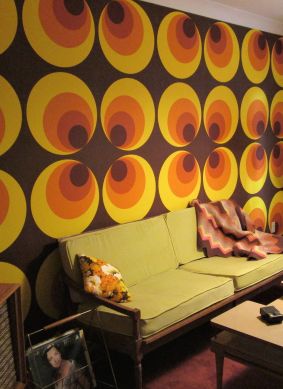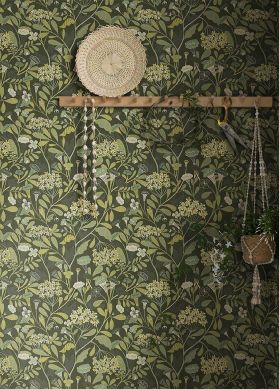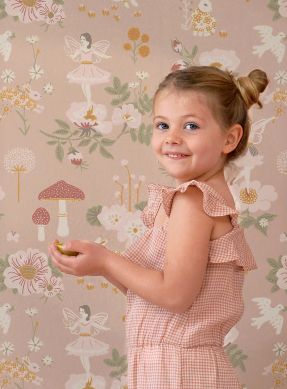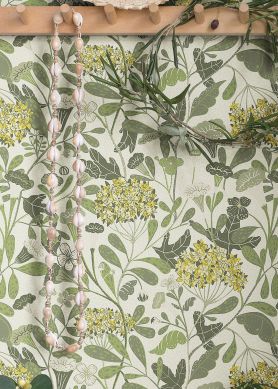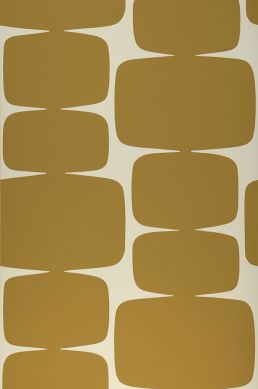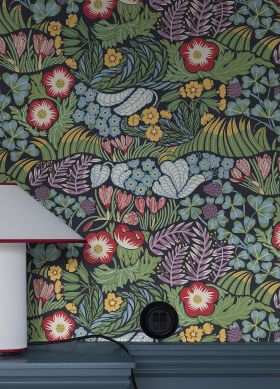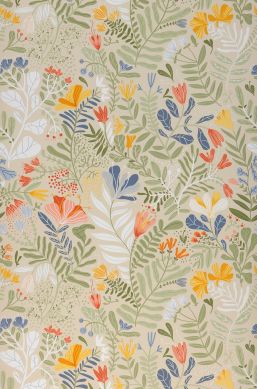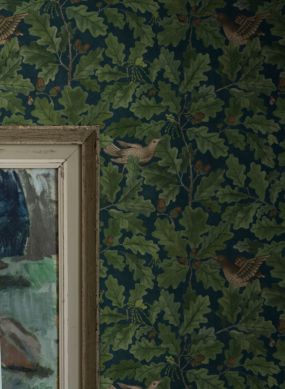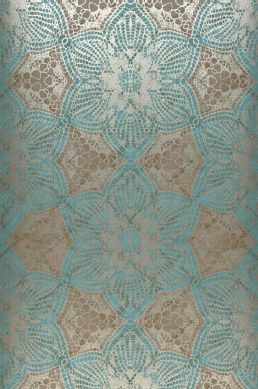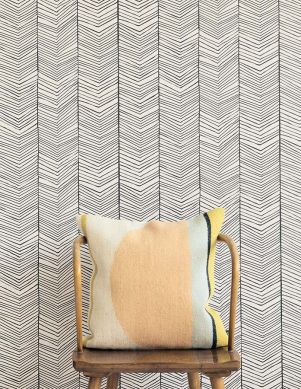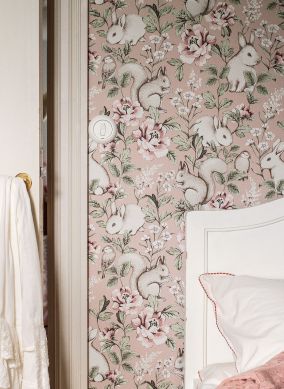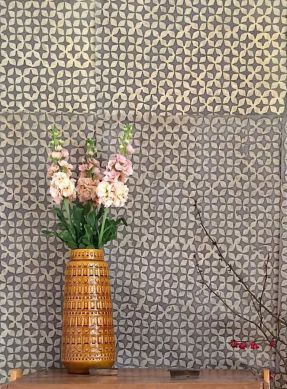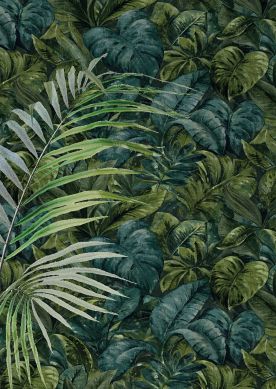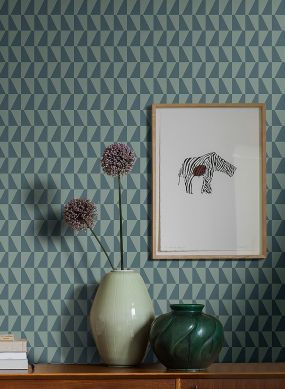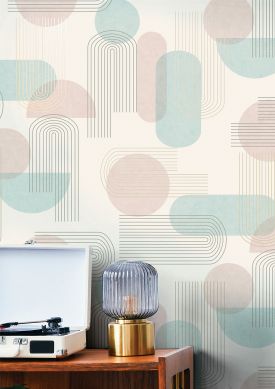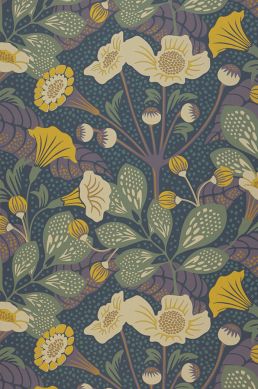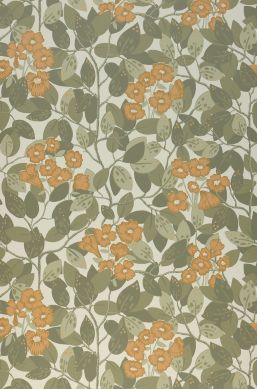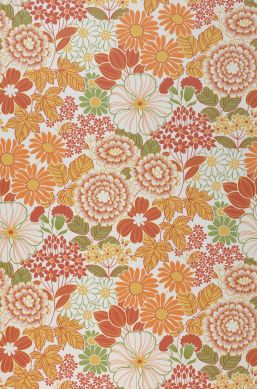Vintage Wallpaper
Vintage & Retro wallpaper - The Guide
Vintage wallpaper is an homage and declaration of love to bygone times. These nostalgic models trigger (or maintain) memories and preserve a way of life, an era, or a personal conviction. Everybody has their very own favourite vintage design which carries specific meaning. In common parlance, original (i.e. old) wallpapers of a certain period as well as new interpretations of original designs are known as "Vintage". We will explain the differences between retro and vintage models, describe both types in detail, including their typical characteristics, and provide design tips.
Table of Contents
- What is Vintage wallpaper?
- What is Retro wallpaper?
- Which colours are typical for Vintage wallpaper models of the 60s and 70s?
- What are the most popular Vintage wallpaper patterns?
- Where to buy Vintage wallpaper?
- What is the special appeal of Vintage and Retro wallpaper?
- In which locations and venues is Vintage wallpaper used today?
- Which famous designers have created Vintage and Retro wallpaper?
- Our tips: How to use Vintage wallpaper for fabulous looks
What is Vintage wallpaper?
The English term "Vintage" describes premium-quality objects which were produced during the actual times they represent. In terms of wallpapers, "Vintage" means that they were produced between the 1930s and the 1980s.
50s Wallpapers
The 1950s saw the beginning of the new post-war construction boom. The new home would not be complete without stylish wallpapers sporting graphic and organic elements, for instance abstract and stylised floral motifs. In terms of colours, pastels were de rigeur, but grey, black, and white, as well as shades of orange and warm reds, were also popular choices. This new futurism signalled departure and change. Textile and wallpaper design went through a period of boundless imagination and creativity.
60s Wallpapers
The 1960s saw in the hippie era. In wallpaper design, this was reflected in psychedelic graphic patterns inspired by Op Art. The hippie movement also developed a specific literary and idiomatic language, as demonstrated in movies like "Yellow Submarine" by the Beatles. Colours became much brighter. Even the most garish shades were now acceptable. But damask patterns in bright colours and adapted to the zeitgeist also enjoyed a huge comeback in the 1960s.
70s Wallpapers
The 1970s were characterised by the new Flower Power era. Even though the hippie movement was slowly coming to an end in the US, across Europe the sense of rebellion amongst young people continued. Wallpaper designs remained colourful, whilst patterns became large-scale, often geometric, and daring. Huge flowers were a popular theme. Baroque and Art Deco elements were combined to create breathtaking designs. Rich colours like orange, green, brown, yellow, and white were the order of the day.
80s Wallpapers
In the 1980s, there was no unified style direction. It was the decade of "mix and match", individualism was the most important aspect, and youth culture seemed to reinvent itself year after year. The 80s were characterised by a large variety of patterns from punky plaid to dandy-like paisley and graphic art in the style of computer-animation or authentic damask elements. Nature and textile wallpaper models filled 80s homes with cosiness. In clubs and bars, metal and spectacular shine and glitter effects determined the look.
What is Retro wallpaper?
The term "Retro" stands for interpretations and imitations based on the trends and designs of bygone times. Retro wallpaper models can be reproductions of original vintage wallpapers, or inspired by old originals but with a modern touch and contemporary colour choices.
Reproductions of original Vintage wallpaper patterns
Things that were popular once will continue to have avid fans in times to come. Just think of the diverse wallpaper designs of the 1970s which are still cult classics. Reproductions of original vintage wallpaper patterns enable consumers to choose their favourite design but with today's excellent quality characteristics.
Vintage-inspired, modern designs
Many designers are inspired by cult classic vintage wallpaper patterns and add their own contemporary touch. These fascinating creations beautifully combine nostalgia and the power of memories with modern designs. Sometimes it's the small-but-clever details that change a popular design, for instance an unusual colour combination.
Production techniques based on the very latest standards
Retro wallpaper models are based on the cult designs of yesteryear, but boast the premium product quality of current standards. The material and surface options are endless. Modern coating or sealing finishes mean that today's wallpapers are robust and have great cleaning characteristics. Wallpapers with low or no contaminants are also meeting health and environment requirements. In addition, recycling, sustainability, and humane production conditions are increasingly important aspects in today's wallpaper industry.
Which colours are typical for Vintage wallpaper models of the 60s and 70s?
Vintage wallpaper models of the 1960s and 1970s are characterised by bright colours, often in striking combinations. Some of the typical hues are blue, brown, green, grey, orange, yellow, and red.
Blue
This cool colour is a favourite for damask-style vintage patterns, but it also plays an important role for pastel Shabby Chic concepts. A warm ocean blue reflects the hippie "drop-out" character and introduces a beach vibe into the room. An intense dark blue emphasises contrasting colours like red, orange, and yellow in abstract "flower power" designs.
Brown
Brown is one of the favourite colours of 70s wallpaper design. Its earthy hues establish a connection to nature and fill the room with warmth and cosiness. The geometric designs of the Flower Power era often came in hues of brown in combination with yellow and white. Mahogany and teak were the fashionable types of wood, and these colours are reflected in wallpapers of the time, too.
Green
Green is the colour of hope and as such it characterises the hippie era with all its aspirations, yearnings and fears. In vintage designs, the colour stands for nature and spirituality, the awareness of one's inner self and the subconscious. The 1970s also saw the beginnings of the environmental protection movement, and many "green" parties and organisations were founded during those years.
Grey
Graphic, geometric, floral or ornamental - grey is a harmonious counterpart to the pattern designs of the 60s and 70s. Grey is calming, provides a subtle contrast, and makes bright colours shine.
Orange
If there was one cult colour for the hippie and Flower Power design era, it was without a doubt orange. The brighter, the better. But lighter and darker nuances were also popular options. Orange symbolises energy, power, activity, it stimulates body and mind. The colour is generally associated with comfort and warmth, it dispels negativity and signals a departure from the mundane.
Yellow
Yellow follows orange in the top ten of colour choices of this exciting era. Joie de vivre, sunshine, brightness, but also enlightenment and rationale are all represented by the colour yellow. Yellow is the colour of optimism and exudes the warmth of a sunny day. For vintage wallpaper, this strong shade is great alone or in combination with other colours.
Red
In the array of typical vintage colours, red should not be underestimated. The colour of love, fire, passion, and courage matched the atmosphere of change prevalent during the 60s and 70s. A dark Bordeaux red adds sensual depth to many a designer wallpaper.
What are the most popular Vintage wallpaper patterns?
Some vintage patterns are easily and instantaneously recognisable, and as a result still extremely popular. Amongst them are large-scale flowers, geometric elements, damask, Shabby Chic, Scandinavian, and Pop Art.
Flowers
On vintage wallpapers, flowers can either speak a clear linear language or form fabulous artistic ornaments. Simplified silhouettes, symmetric arrangements, and large-scale pattern formats in bright colours characterise the floral designs of the 1950s - 1970s. The counterpart came in the shape of floral pattern ornaments inspired by historical examples like the Renaissance, Baroque or Art Nouveau.
Geometric
Geometric shapes and graphic elements are typical for wallpaper design of the 50s, 60s, and 70s. In the 60s, psychedelic designs were incredibly popular; Op Art artists like Victor Vasarely were the inspiration behind many optical illusion motifs. In the 1970s, the focus moved to geometric elements with three-dimensional effects.
Damask
Elaborate ornaments consisting of floral, figural or imagination-driven elements form fantastic damask-style patterns which stand for opulence and luxury. These opulent patterns can enter a striking partnership with simple geometric shapes. The choice of colours and special effects provides an individual note.
Shabby Chic
Shabby Chic wallpaper patterns come in a huge variety of visual options, but they all have one thing in common: They show the charming signs of the times, for instance flaked, sun-bleached colours, corrosion, weathering. Traditional tiles, weathered wooden planks, rusty metal plates, old concrete and stone walls are just some examples for Shabby Chic wallpaper designs.
Scandinavian
Internationally renowned design with Scandinavian roots, inspired by artists like Panton, Jacobsen, Eames, or Lindberg. Who doesn't know them, the legendary furniture and textile design classics? The simple geometry of Scandinavian wallpaper patterns follows the strict rules of symmetry - and the effect is simply irresistible.
Pop Art
Pop Art is when everyday objects become art. This creative style, which originated in the 1950s and reached its peak in the 1960s with its most famous representative Andy Warhol, is a popular theme for vintage wallpapers. Lettering, alphabetic characters, geometric shapes, figures, objects, and portraits are mixed with bright colours to create a unique look.
Where to buy Vintage wallpaper?
The supply of original vintage wallpaper is limited, its availability partially determined by the specific period. The most likely sources are to be found in small ads portals or specialised shops and the remaining stock is predominantly from the 50s - 80s.
Small online ads like Gumtree
Online ad portals like Gumtree are popular platforms when searching for original vintage wallpaper. Private individuals will offer stock they may have found in basements or lofts. A glance in the classified ads of your local paper might also come up with some results. Another good option (often with better chances of finding the desired items) is the auction platform eBay, with national and international offers.
Online wallpaper shops
Some online wallpaper shops have specialised exclusively on original models from the 1950s to 1980s. Many of them have their own stock. The owners look internationally for remaining stock of the most popular decades and buy in bulk whenever possible. Sellers range from private individuals to wallpaper shops and small manufacturers.
Tip: Liquidation of old wallpaper shops
With a bit of luck, original vintage wallpapers can be found when wallpaper shops are closing down. These opportunities can be found via online ads, notifications in shop windows, announcements in newspapers or newsletters, and auction notices.
What is the special appeal of Vintage and Retro wallpaper?
Vintage and retro wallpaper has an inherent charm which consists of a number of individual aspects. Nostalgia, trendiness, history, personal yearnings, or simply their fun character - just a few possible reasons that make them so appealing.
Nostalgia
Grandma's kitchen wallpaper is directly associated with a delicious Sunday roast. A favourite pub's charm is partly due to its orange wallpaper from the 70s with huge flowers, setting the scene for a love and peace wonderland. Retro and vintage wallpaper models remind us of our own childhood and youth, of special places and locations, of experiences and adventures. They are like a piece of immortality. And they place a pleasing mythical veil over our lives - because the colours of our memories are always brighter, and the grass is always greener.
Cultural and art history
Vintage and retro wallpapers are testimony to cultural and art history, they represent a glance into different eras with their specific style and highlights. A brightly coloured graphic wallpaper with psychedelic pattern print reminiscent of Woodstock and the hippie or Beatles era can create a fabulously authentic ambience. Highlights from the worlds of design, creative art, and music are represented in vintage wallpapers. And various styles of living throughout history, from mediaeval times to today, can be reflected in retro wallpapers.
Longing for a simpler world
Everything was better in the olden days - a sentence that can often be heard. Even thought that is not necessarily true, the fact remains that things might have been less complex. When we look back at bygone times, we see life and events through a filter. We tend to block out unpleasant or difficult experiences and remember mostly the positive aspects. There is no doubt that humans have recently gone through incredibly fast and complex changes in all areas of life, mostly due to breakneck-speed technical progress. Vintage wallpaper is a way to preserve the good, the beautiful and the uncomplicated forever.
Cheerful colour and pattern design
Bright colours, flowers, blossoms, leaves, playful ornaments and crazy geometric shapes - the lightness of being finds its carefree expression in vintage and retro wallpaper models. Departure, revolution, freedom, spiritual experiences, and the expansion of consciousness are all terms that reflect the importance of individual happiness. A colourful, unusual wallpaper plays its part in this endeavour.
In which locations and venues is Vintage wallpaper used today?
Vintage wallpaper boasts an incredibly versatile spectrum of use. These stunning models are suitable for private premises, cafés or trendy bars; as decorations in shops or shop windows they are true eye-catchers; and last but not least, they provide authentic backdrops in movie studios and advertising campaigns.
Trendy bars, cafés and clubs
The ambience is the main ingredient of what makes trendy bars, cafés and clubs successful. Vintage and retro wallpaper models are the perfect tool to translate a specific theme or motto. They can create a futuristic, cosy, whimsical, stylish, or glamorous atmosphere and make a venue irresistible to the relevant target group. In addition, retro wallpaper is an effective marketing tool for the latest "place to be".
Shop design and window dressing
In shops - and not just the ones specialising in all things vintage - the right "purchase climate" can be created by vintage wallpaper décor. This will trigger positive memories, evoke a visual and emotional sense of the past, and make full use of the nostalgia factor. Furthermore, a trendy, colourful pattern wallpaper in a retro style works as an eye-catcher and sparks the customer's interest in the shop, even in passing.
Movie studios and the advertising industry
Movies and TV series set in bygone times are unthinkable without authentic or cleverly recreated backdrops. As a result, movie and TV studios are amongst the most frequent and enthusiastic buyers of vintage wallpaper. The fabulous choice of deceptively realistic retro wallpaper models serves any genre from "Sword and Sandal" movies to music films set in the 80s. The advertising industry transports effective slogans via vintage settings.
Living rooms, bedrooms, and kitchens
"I love Vintage" - fans of nostalgic concepts adore vintage wallpaper models in their own four walls, above all in bedroom, living rooms, or kitchens. Furnishings and furniture that go with this style can also be vintage, a mixture of old and new, or even totally contemporary.
Which famous designers have created vintage and retro wallpaper?
Vintage is a focus theme with designers of all genres. This is true for design legends like Stig Lindberg and Arne Jacobsen, but also for new shining lights like Dupenny or Orla Kiely.
Orla Kiely
Exceedingly popular Irish textile designer Orla Kiely draws from the funky Flower Power of the 1970s and succeeds in giving this theme her own very recognisable touch. Buttercups, climbing roses and other floral favourites, plant elements and cute animals take on a clear, simple, symmetric and very colourful form. Amongst her many popular wallpaper models are beauties like Multi Stem, Linear Stem, Acorn Spot, Striped Petal. Other models boast striking graphic structures and shapes.
Dupenny
British designer label Dupenny was founded in funky Brighton and creates sustainable retro wallpaper models which depict the glamour, fashion, and dance styles of the 1940s and 1950s in a whimsical and witty manner. Anything goes, from sexy pin-up girls and housewives to typical fashion items of the 50s. The colour choice for most Dupenny wallpaper models is deliberately black and white, whilst some have strong colour accents. All are produced using manual silk screen printing techniques.
Arne Jacobsen
Arne Jacobsen is a cult favourite. With his designs in the functionalism style, the Danish architect and designer (1902 - 1971) has written history. Organic and botanic shapes influence the furniture and product design of the artist who was a master at creating abstract interpretations. Amongst the world-renowned pieces of seating furniture are: the Ant chair, the Egg chair, the Swan chair, or Series 7. Another one of his passions was textile design. Many of his graphic patterns continue to be the basis of modern Scandinavian looks, particularly for wallpapers. Amongst them are Vertigo and Trapez, to name just two examples.
Stig Lindberg
The Swedish designer, ceramicist, painter, and illustrator Stig Lindberg (1916 - 1982) is considered to be one of the most important representatives of the modern movement in Sweden and enjoys cult status. In cooperation with Astrid Sampe, he developed playful surrealist textile prints like Melodi, Pottery, Lustgarden, and Friktada between 1947 and 1954. Despite their vintage character, they have outlasted all changes in style and look contemporary and modern to this day. Along with his graphic-geometry pattern creations in the area of porcelain painting, or the beautiful illustrations in children's book "Krakel Spektakel", these designs have been eternalised in wallpaper models and turn any wall surface into a stunning work of art.
Our tips: How to use Vintage wallpaper for fabulous looks
- Create your very own luxurious bathroom in a Baroque style. Choose a deep red or deep purple damask wallpaper with golden relief pattern and use it on all walls of the bathroom. In terms of ceramics and furniture, stick to white, with fixtures and details in gold or brass.
- Relax in a cool blue "Vintage Salon" complemented by a striking pattern mix. Select a geometric vintage wallpaper and combine it with a retro-style floral model. The colours for both wallpaper models should be royal blue, steel blue, and green blue, in keeping with the blue theme. Antique-style furniture upholstered in velvet and a soft thick rug - all in shades of blue - complete the look.
- Kitchens in an appetising flower power style: A large-scale graphic or floral pattern in hues of orange and yellow typical for the 70s is perfect for feature walls in kitchens. Combine contemporary white kitchen units with design classics like a Tulip table and Panton chairs.
- Stimulating Op Art for offices or studies - create a stunning feature wall to add interest. More often than not, the wall behind the desk is the best choice for this kind of project. A great suggestion is a black-and-white pattern wallpaper in a subtle Op Art design. The remaining walls should be painted in a neutral white or off-white colour. In terms of furniture, less is more.


